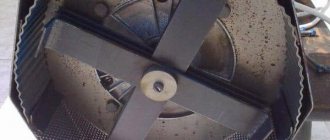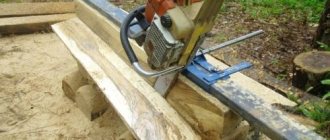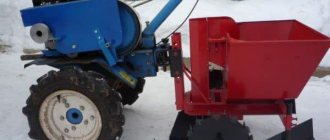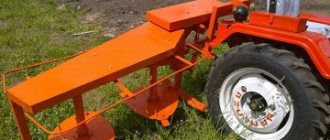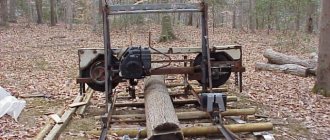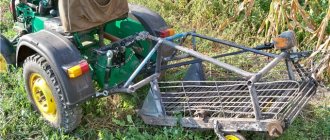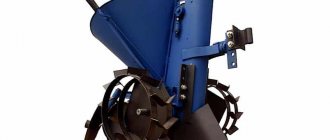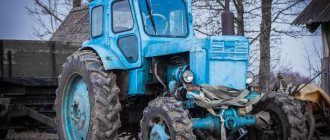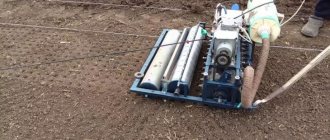The processing and mining industries work with stones and hard rocks that are difficult to crush. In this case, a special crusher is required that can quickly and efficiently complete all the assigned work. But if we are talking about crushing stone at home in order to equip a private enterprise, then a device with low power will do, and if you wish, you can do it yourself.
The mini stone crusher is practical, compact in size and has convenient functional features for use in accordance with the established standards.
Coal crusher
Hi all!
A problem has arisen (I bought a coal-fired heating boiler and it requires a fraction of 30-70mm.) And my coal has a regular fraction of 200mm or more! So I wanted to build a crusher, I beg you, if anyone has any ideas, please help me. That no one has any ideas?
Description and operating principle of a jaw crusher. " >
a concrete mixer and several metal blanks (in general, balls are preferable), the crushing time should be determined experimentally
Vidis wrote: a concrete mixer and several metal blanks
This will not be a crusher, but a mill - a bunch of dust (very explosive, by the way) and small fractions. If we take industrial equipment as a basis, the simplest thing is to build a smaller model of a jaw crusher (the movable jaw is made of steel channels welded to each other, the cavities are better filled with concrete for rigidity, the stationary one is reinforced concrete lined with steel sheet) the drive is hydraulic - simpler or eccentric - more productive.
johnlc wrote: the easiest thing to do is to build a smaller model of a jaw crusher
Are you kidding?
With such a jaw - and you need about 250 mm - the result is not a model, but a full-scale crusher, perhaps narrower: the gripping angle cannot be canceled and it would also be good if the plates were corrugated or with surfacing. Kmk, it’s impossible to fit into a ton of metal here. But nothing real comes to mind. kwetkin, You could say how much she will eat, the possibilities of production, maybe what is ready-made in stock.
Borrow a shaker from the builders, make a grate of the required size according to the size of the sole, install it on top of the bunker. Pour the semi-finished product onto the grate and go to battle_! Screener/crusher in one bottle
Malevich wrote: Kmk, you can’t fit into a ton of metal here.
That’s why I proposed to do it – a hybrid with reinforced concrete – the weight will actually be greater, but the price will be less. for a budget option, you can add a type of piledriver falling into the bunker and a grate at the bottom of the desired mesh size.
It’s better to borrow a couple of Tajiks for sledgehammers from the builders. PS, if the boiler does not eat more than 100 kg per day, a sledgehammer and an inclined grate will solve all the problems - at the same time, morning exercise.
The boiler currently eats 3-3.5 buckets per day, but the sledgehammer really sucks. la
kwetkin, What if you make a couple of gears, something like rollers, or make a sprocket for large toothy chains...
emnip coal is a rather fragile but abrasive material.
I propose to discuss a sketch of a small-capacity coal crusher!
As a diagram, it’s good, only in roller rotors the rotor has to be tricky: “> otherwise a large piece won’t fit down her throat. The speed and, accordingly, the power may be lower, but there is no escape from the moments and efforts.
kwetkin, Now, if you hang the upper part of the armor on hinges, and connect the lower part of the armor with a crank to a shaft, with a stroke of 10 mm. This will make it better to chew and not choke. At the crusher below, a comrade threw off the power and speed, and you have some chips for yourself. .
Malevich, I think it’s a great idea about the mobility of the armor, but here’s another question: which pulley to put on the main shaft?
I don’t understand - what is being offered, a hybrid of roller and jaw or purely jaw?
kwetkin wrote: what pulley should I put on the main shaft?
If it's a gear motor: adjust the speed...
Malevich wrote: it is proposed, a hybrid of roller and jaw
-pressure with broach :yu
It's clear. Surely, with the same success, you can seat the rotor eccentrically and get periodic pressure peaks during supply. And there is no need to make an additional movable, highly loaded link. The next step in the same direction is a faceted shaft, then attach teeth to it for better tightening of the material and in the end we will get the construct from post #13. There is no need to expect miracles in this area, and possible designs for mechanical shredders have long been polished to perfection. To begin with, if we are talking about a roller crusher, we need to decide on the size of the rotor: because with a small diameter, a large piece will not fit into its throat. Imagine that an asphalt roller runs over an inch pipe - literally, into a pancake. And if the pipe is half the size of a roller, he will drag/roll it in front of him. The analogy is somewhat arbitrary, but the physical meaning is the same and for the initial pieces of 200 mm, a smooth rotor will require more than a meter in diameter (offhand, I didn’t count). And this is not only the metal itself, but also the corresponding loads in the drive elements. Or make a deliberately large distance to the slab in order to reduce the approach angle, but then the coarseness at the exit may not suit you.
I mean, what's the point? I would like to get away from industrial solutions altogether and closer to a sledgehammer, but as if with an electric drive. Imagine a gutter, the bottom of which is a grate, and a barrel tightly packed with iron scraps (or concrete, or lead shot, or even mercury o_O) can roll along its side walls. The width and depth of the trench are based on the maximum coal size, and the length. let it be three meters to start with. The barrel has two or three welded toothed hoop disks that are more than half the height of the side walls and move inside the trench. To roll the barrel, we will give it axles, which we will connect with a cable (through bearings) to a small winch. We will install the chute with a lift to the winch so that the working stroke is forced, and the return is downhill. You can do it horizontally, but then drag it in both directions. And we kind of went: back and forth, in the manner of that skating rink, but also studded. There are several musical moments here:
- How much weight does a barrel need to crush the product? Don't know. The last time I held coal in my hands was about twenty years ago. It is possible, probably, to carry out some kind of experiment on the spot to find out: say, hinge a strip on an edge and press through a long lever. If it doesn’t work out, the idea goes straight to the trash; It needs to be guaranteed to be fine.
- Barrel weight. The more, the better, but if 200 liters are packed tightly with iron + concrete, it will weigh more than a ton. How to mount it and where to put it if something happens? (With fractions it’s much easier).
- I also don’t know how the coal will split - if large flaky (flat) pieces come out, that’s also bad: they might get stuck between the disks and you’ll have to knock them out with a sledgehammer. Stop! Why discs and not ribs along the barrel? Or individual studs in a checkerboard pattern? In general, ask the price on the spot; but purely speculatively it is difficult to advise something more specific.
Step-by-step instructions for creating a garden model
Every gardener knows what spring pruning of trees is. And he knows that after it a new problem appears - where to put the branches. You can make compost out of them, of course, but there is a way to get it much faster than just throwing the branches (as they are) into the compost pile. They just need to be crushed, then the compost can ripen within a season, or even faster.
To build a garden shredder you need to prepare:
Once everything is in front of you, you can move on to the creation process itself.
What’s good about a homemade shredder is its reliability and operation, as they say, without undue embarrassment. It will do an excellent job with the same branches, and with other household garbage, and crushing fruits (directly with seeds). Finally, self-production is also a matter of saving. A homemade product, even if it breaks at some point, will not require the purchase of a specific expensive part (as will happen with a store-bought crusher); it can be repaired with something readily available, inexpensive, and available on the farm.
Types of crushers
5 classes of crushers based on the shape of the crushing mechanism :
- Jaw (crushing is carried out by crushing between two cheek plates);
- Conical (crushing occurs inside the conical bowl);
- Roller (the material is crushed between cylindrical rollers rotating towards each other at the same speed);
- Hammer (material is crushed by hammers);
- Rod.
Roller and hammer mechanisms are used for crushing brittle and soft materials, such as coal, chalk, limestone, etc.
Crushers of other classes crush hard materials, for example, building stone.
Different materials require different processing approaches.
- In the case of hard and abrasive materials, the crushing method is used;
- For strong and tough ones - crushing with simultaneous abrasion;
- Soft and fragile - splitting method.
Using crushers, hard and soft rocks, metallurgical waste, plastics, polymers, wood, municipal solid waste and organics are processed.
By design, crushing mechanisms are divided into:
- Knife shredders - used for primary crushing of solid materials (wood, metal, municipal solid waste, rubber, polymers). For subsequent grinding it is necessary to use a different type of mechanism.
- Rotary knife . Typically used for recycling polymers.
- Jaw grinders are used for crushing the most complex and hard materials and for grinding asphalt, reinforced concrete and building stone. It is also possible to successfully grind more fragile materials (glass, ceramics).
- Conical . Used for crushing very durable building materials.
- Roller.
- Hammers are used for crushing fibrous non-solid materials, as well as for processing brick chips, electrical waste, glass and ceramics.
Other designs
There are different crushers, their main difference from each other is the processed material. There is a fundamental difference between a machine that shreds cardboard or foam rubber, and a machine that is suitable for rubber (tires, tires) or, for example, expanded clay. Crushers are also made to crush bird bones. You can make a glass grinding machine yourself.
Use elements of used equipment: washing machine, meat grinder, grinder, etc. The main thing is that the principle of operation of the device is observed . Figuratively speaking, this is the principle of a meat grinder, in which the material passes through the drum/reception bowl, ends up in the crushing system and is effectively crushed. The department where the material is ground is represented by cutters and a milling cutter. The raw material will be processed until it reaches the required grinding size.
For example, until it becomes metal shavings or sawdust
With the help of a gear-rotor crusher you can crush even asphalt and clay. The roller system is most often used for grain processing. And there are a great many examples of such structures. But if you look at the step-by-step instructions for making a garden crusher, a device for any other material will be made according to the same basic plan. Only its power, size, number of saws, etc. will change.
Jaw crushers
Jaw mechanisms are classified as periodic machines.
The stone is destroyed between two plates (cheeks), one of which is movable, the other is not. The cheeks move and crush the material. This is one of the most popular crushing machines. It is used to destroy rocks of any strength and all types of crushing. The design of the crushing plate fasteners makes it easy to replace them if necessary. The permissible size of the material used depends on the width of the receiving hole. When the jaws come together, the material is crushed; when they move away, the material falls to the outlet of the crusher.
The advantages of jaw crushers include reliability, simplicity, ease of maintenance, compactness and a wide range of applications.
Disadvantages: frequency of exposure to the processed material, insufficient balance of moving masses, which creates a lot of noise. To reduce it a little, you can place the mechanism on a heavy foundation and additionally equip it with heavy flywheels.
Cone crushers
To crush material of medium and high hardness, cone crushing mechanisms .
This type of crusher consists of two cones inserted into one another. Moreover, one of them is motionless, and the other makes circular movements. In order to pass unbreakable pieces, the movable cone moves away from the movable one, thanks to a system of spring shock absorbers. The latest generation of cone crushers are equipped with hydraulic pressure. The size of the product can be changed by changing the gap between the cones.
The cone crusher is one of the easiest to operate and reliable units. Used in construction, metallurgy and chemical industry.
Advantages: continuous impact on the material, good balance, high productivity.
Disadvantages: high energy consumption, large dimensions.
Impact crushers
Rotary crushers are used to grind small and medium-hard products . Crushing is carried out by blows of special beaters mounted on a rotor rotating around a horizontal axis. The large reserve of kinetic energy allows this model to be used for coarse crushing with a high degree of grinding. Models are divided into single-rotor and multi-rotor. Impact crushers are used to produce concrete aggregates and various sludge materials. Compared to jaw and cone crushers, rotary crushers are a highly efficient type of crushing apparatus.
Search your favorite song right now
1. Do-it-yourself mini brick, stone, concrete crusher!
- Published: 2 years ago
- Duration: 4:15
- By
I tested the crusher, it turned out very well.
2. DIY mini brick, stone, concrete crusher!
- Published: 1 year ago
- Duration: 29:01
- By
Making a stone crusher! With my own hands. Tests with ores will be in the next issue, it is already known.
3. DIY brick crusher VK408226779
- Published: 1 year ago
- Duration: 3:04
- By
jaw crushers to order 89657012103.
4. Jaw crusher for stone
- Published: 11 months ago
- Duration: 3:14
- By
Crushers to order. Belgorod Mini crushers, gross, shredder. +79517654312.
5. homemade mini crusher for brick and stone
- Published: 4 years ago
- Duration: 6:49
- By
A homemade jaw crusher, assembled almost on the knee, without drawings, without any hints.
6. Homemade jaw crusher + detailing (part 1).
- Published: 2 months ago
- Duration: 13:01
- By
Homemade jaw crusher for processing construction waste into raw materials for the production of blocks.
7. jaw crusher for processing construction waste!
- Published: 1 year ago
- Duration: 1:04
- By
homemade crusher for brick and stone.
8. jaw crusher 220 volt VKontakte 408226779
- Published: 8 months ago
- Duration: 4:06
- By
jaw crusher for 220 volts, description of the crusher, operation of the brick crusher.
9. Crusher
- Published: 1 year ago
- Duration: 2:06
- By
Homemade coal jaw crusher.
10. Shredder (shredder) for construction waste
- Published: 1 year ago
- Duration: 1:17
- By
We offer equipment of our own production. This model is used for crushing fragile, even.
11. jaw crusher tel. 89657012103 VKontakte408226779
- Published: 1 year ago
- Duration: 2:18
- By
Custom crushers crush brick, concrete, quartz and other similar materials. low price.
12. homemade jaw crusher for stone
- Published: 3 months ago
- Duration: 0:39
- By
- Published: 9 months ago
- Duration: 1:47
- By
Granite crusher, armor jaws 300x200mm, 7.5kW/380V Price - 36000 UAH Contacts for orders: +38 050 4571330 (Viber, .
14. Mini crusher Caesar 1
- Published: 4 years ago
- Duration: 2:25
- By
15. Recycling of concrete, brick and other stone materials as a business idea
- Published: 8 months ago
- Duration: 4:18
- By
Production of recycled crushed stone from old concrete and sand from broken bricks. Everything you need is equipped.
16. mini jaw crusher
- Published: 2 years ago
- Duration: 2:15
- By
17. Homemade mini jaw crusher. Stone crushing.
- Published: 4 years ago
- Duration: 5:28
- By
A homemade jaw crusher breaks natural stone.
18. Concrete crusher. BUCKET PLANT
- Published: 5 months ago
- Duration: 0:59
- By
19. Dsch80-100 crushed stone brick crusher marble mini
- Published: 6 years ago
- Duration: 0:19
- By
20. IVZ 2-260 - crushing bricks.
- Published: 5 years ago
- Duration: 1:42
- By
Recently Searched
Hammer crushers
Hammer crushers resemble rotary crushers. The material is crushed by rapidly alternating blows of hammers hinged on a rotating rotor. Hammer crushers crush medium-hard mineral material. They are used in the production of glass and building bricks, for crushing dry clay, coal, and broken bricks. Typically, such a crusher is light in weight and low in cost. There are single-rotor and double-rotor crushers.
Recently, reversible hammer crushers, in which the direction of shaft rotation can be changed, have become increasingly widespread. A significant disadvantage of hammer crushers is the rapid wear of the hammers and their use only for crushing low-abrasive rocks, large dust formation, and the lack of mechanisms to prevent breakdowns when uncrushable parts enter.
The advantages include a high degree of crushing, which avoids re-processing, low energy consumption and light weight, ease of design and maintenance.
Drawings and 3D models of various crushing equipment
The working bodies of the roller crusher (Fig. 3)
Rice. 3. Roller crusher: a) Design; b) Crusher diagram
are two parallel cylindrical rolls 2
and
4,
rotating towards one another. A piece of material entering the working area is carried away by friction against the surface of the rolls and is drawn into the working space, where it is crushed as a result of splitting, fracture and abrasion.
The surfaces of the rolls are made smooth and corrugated. Rolls are mounted on the frame 1
in bearings
3
and
6.
The bearings of one or two rolls have spring supports
5,
which can move in the guides when an uncrushable object enters the crusher.
The rotation of the roll is transmitted from an electric motor through a V-belt transmission with a frequency of 75...190 min-1.
The largest size of a piece of material loaded into the crusher depends on the grip angle, determined by the diameter of the rolls and the coefficient of friction on the metal surface of the rolls. In order for smooth rollers to be able to capture the initial product in the crushing zone, it is necessary that the angle of capture of the rolls does not exceed the angle of friction of the material on the surface of the rolls.
The maximum size of pieces depends on the diameter of the rolls and the size of the discharge slot. To meet these conditions, the diameter of a smooth roller should be 20 times greater than the size of the stone, and with grooved surfaces of the rollers - 12 times. Therefore, roller crushers are used only for secondary crushing of rocks of medium and low strength, as well as for grinding viscous and wet materials.
The degree of grinding is 4...12. The crusher size is characterized by the diameter and length of the rolls.
Productivity of roller crushers (M3/H) PT = 3600 aL R, where a -
width of the unloading slot, m; L—roll length, m; — peripheral speed, m/s; R is a coefficient that takes into account the use of roll lengths, the degree of loosening of the material, and uneven feeding; R = 0.1...0.3 for soft and R = 0.4... 0.5 for hard rocks.
4) Impact crushers
Impact crushers are used for crushing soft and medium hard rocks (limestone, chalk, gypsum, coal, etc.).
Crushing in an impact crusher occurs as a result of the impact of rapidly rotating hammers on pieces of material and the impact of the pieces against each other, the impact of the material on crushing plates onto which it is thrown by hammers, the crushing of material between hammers and the crushing plate, as well as between hammers and grates.
The following types of impact crushers are distinguished: hammer crushers with hinged hammers, impact crushers with rigidly fixed beaters.
Figure 1.4 Diagrams of impact crushers.
Impact crushers are classified according to the following criteria: - By the number of rotors - single-rotor crushers (Figure 1.4 a), double-rotor crushers (Figure 1.4 b), hammer crusher (Figure 1.
4 c) - According to the design of the impact surfaces - rotary crushers with grates and impact - centrifugal crushers with smooth impact plates. According to the principle of crushing in two-rotor crushers - parallel and sequential.
Advantages of impact crushers: high degree of grinding (up to 30) and low specific energy consumption. They can carry out coarse, medium and fine crushing.
Disadvantages of impact crushers: the ability to crush only non-abrasive rocks with a strength of up to 1200-1500 kg * s/cm2, mainly limestone, rapid wear of the hammers, if pieces of metal can get into the crusher, breakdown occurs, if the material moisture content is more than 15%, the crusher is smeared, the unsuitability of hammer crushers for crushing very hard rocks.
Runners.
The runners are widely used for fine and fine crushing of soft rock materials of medium hardness. Figure 1.5 Runner patterns.
Runners are classified according to the following main characteristics: - By mode of action: periodic (Figure 1.5 a) and continuous (Figure 1.5 b,c,d) - By technological purpose: for grinding and mixing and only mixing, for briquetting the raw mixture, runners are also distinguished with metal rollers and bowl and stone rollers and bowl.
According to the design: with a stationary bowl (Figure 1.5 a, b), with a rotating bowl (Figure 1.5 c, d, e), with an upper (Figure 1.5 a, c, d, e) and lower (Figure 1.5 b) drive . With a bottom drive, disassembly is more difficult, repairs take longer, but the mass is not contaminated, with rollers resting on the material with their mass (Fig. 1.5 a, b, d) with additional hydraulic, pneumatic (Fig. 1.
5 c) or with spring (Figure 1.5 d) pressing on the rollers. By unloading method: with manual unloading (Figure 1.5 a), with pressing through a grate (Figure 1.5 b), with centrifugal unloading (Figure 1.5 c), with unloading via a dump lowered into a bowl (Figure 1.5 d).
In runners with rollers rotating around a vertical axis, centrifugal forces tend to tear the rollers off, and if unbalanced, the central shaft can bend.
Advantages of runners compared to roller crushers: it is possible to unload significantly larger pieces of material, it is easier to regulate the fineness of grinding, the plastic properties of clay materials are improved due to the repeated impact of rollers. Disadvantages of runners: bulkiness, difficult repairs, increased specific energy consumption per unit of processed material.
Crusher
How to make a crusher with your own hands
Having basic knowledge of physics, it is quite possible to make a crusher with your own hands. As a rule, a low-power electric motor , usually no more than 1 kW.
There is a technique that helps to design a mechanism with the necessary characteristics. First, you need to decide on the material to be processed.
- In order not to complicate the design, it is better to make a mechanism with one movable cheek . For a fixed cheek, a cast iron sheet is suitable, which is installed at an angle on a solid base. The slope is required to create an upper hole for filling the material. Also, by changing the angle of inclination, you can adjust the crushing gap.
- metal shaft as a movable cheek . It is driven by an electric motor through a belt drive, which is needed to reduce the number of revolutions and increase the load characteristics of the engine. In case of overload, the belt drive will avoid jamming.
- The rotation of the shaft should be directed towards the product filling.
- The crushing parameters change when the lower attachment point of the fixed cheek is shifted.
- The entire mechanism can be placed in one housing, and a hopper can be made on top for loading.
For household use, as a rule, crushers made from improvised materials are used. At its core, it is a container with a shaft mounted on bearings and several knives. The shaft rotates thanks to an electric motor through a belt drive. To regulate the speed of rotation of the shaft, wheels of different diameters are installed.
A common use of such mechanisms in the household is chopping vegetables , herbs, etc. They can also be used in construction, for making gravel or crushed stone.
Homemade brick crusher
There are also shaft crushers: two cylindrical shafts rotate at equal speed towards each other.
Finally, they get down to business with a grinder with a hammer mechanism - the brick is destroyed with a hammer.
Let us list the design nuances of a homemade brick crusher.
Taking these fundamental points into account, you can make a crusher yourself. This is a container with a shaft on bearings, on legs. An alternative can be a cone crusher: these are two large cones located opposite each other.
The crusher starts up, and the cones begin to sequentially destroy the material.
